Contents
Common thyme or thyme is widely distributed in almost all parts of the world. Its medicinal properties have long been used in folk medicine to treat ailments. Spicy delicate aroma allows the use of the plant in cooking, perfumery. Landscape designers did not bypass it either – thanks to its decorative creeping properties, thyme has become a real decoration of flower beds, alpine slides. And all because this fragrant herb is well adapted to any climatic conditions, and its cultivation is possible everywhere: in the garden, in the garden, in a pot on the windowsill.
Description of common thyme
Common thyme is a perennial herbaceous shrub, a popular representative of the Thyme genus and the Yasnotkov family. All plants of this genus are distinguished by a high content of essential oil and tannins, phenols, terpenes, fatty acids, which explains the sharp spicy taste and characteristic aroma of the herb. In addition, thyme contains organic pigments, minerals and vitamins, which are very important for health.
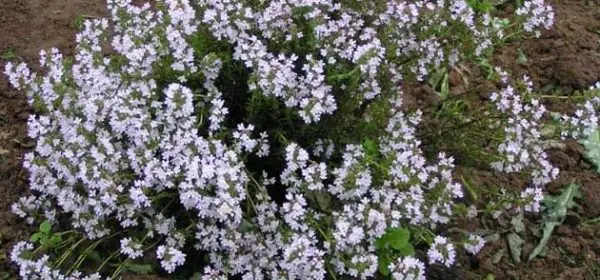
The genus Thyme includes about four hundred different species. Only on the territory of the CIS countries is known and grows up to two hundred of them. Depending on the variety, shrubs differ in the shape and color of the leaves, the color scheme of the inflorescences. Some of them have the form of a compact ornamental bush with a height of 15 to 30 cm, while others are elongated creeping shoots about 5 cm high, densely covering the ground.
The most famous species of this genus is common thyme, which includes undersized subspecies, and on the basis of which many different hybrids have been bred. Externally, the plant is quite compact, has the form of a low (up to 15 cm), sprawling bush with light green leaves and white or light purple small inflorescences.
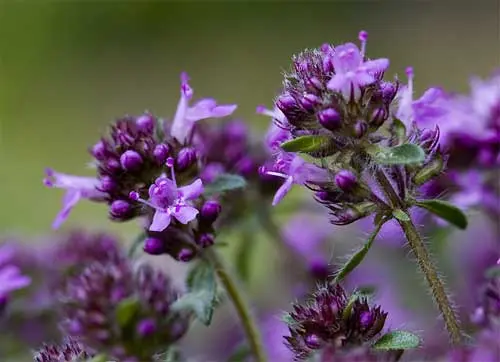
Grass stems are woody at the base, well branched, abundantly covered with small leaves along their entire length, with a slight grayish pubescence on the lower part. Depending on the variety, the grass may have long shoots that curl close to the ground, strengthening roots in it. Flowers, collected in elongated or spherical inflorescences, are located on the tops of the branches.
The taste of thyme is sharp, spicy, slightly bitter, the aroma is subtle, slightly spicy, somewhat reminiscent of a mixture of cumin, lemon and anise. The grass blooms throughout the growing season from June to September. And only in the middle of autumn, fruits develop from the inflorescences. Thyme seeds have a slightly elongated or spherical shape and are located in a box of 3-4 pieces.
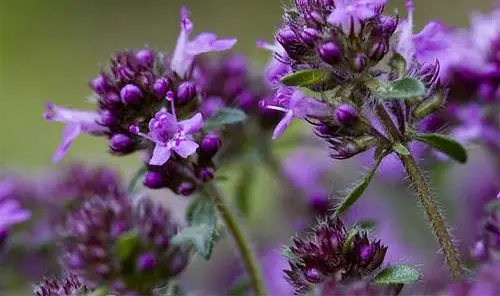
The high concentration of essential oils in thyme endows the herb with disinfectant and anti-spastic properties. With its help, gastric, pulmonary, hepatic pathologies are treated, and they are taken in inflammatory processes. Thyme is an ingredient in many herbal remedies for asthma, bronchitis, coughs, and inflammation of the mouth and throat. Tea with thyme improves appetite, normalizes sleep, relieves pain, and has an expectorant effect.
Video “All about thyme”
Demonstrative video with information about thyme.
Cultivation and reproduction
Growing thyme is possible anywhere, and in any way. If there is a land plot, grass can be sown in the spring in the garden. In winter, as well as in harsh climates, this culture is not difficult to grow in the house. In a flower pot on the windowsill, spicy greenery will not only always be at hand, but will also create coziness in the room due to its decorative appearance.
It is not difficult to grow thyme, however, in order to obtain high-quality fragrant greens, it is necessary to create suitable conditions:
- common thyme is a very light-loving herb, so it should be planted in the most lit place where there is no shade – if the spice is grown in the house, then the pot should be placed by the window facing the sunny side;
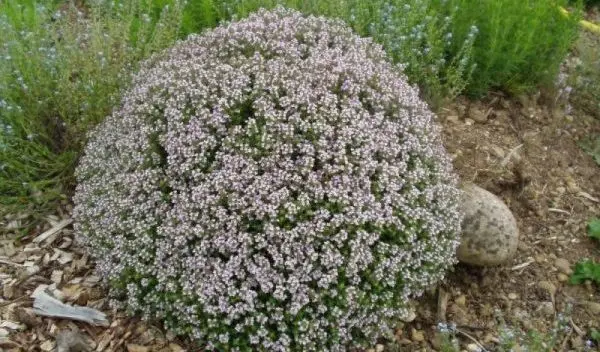
- germination of thyme seeds occurs faster in warm and moist soil, in this regard, sowing is best done no earlier than May, while the soil needs to be well watered – to get an early harvest, you should resort to planting spices from seedlings, while choosing early varieties of grass;
- thyme does not tolerate excessive moisture – it requires moderate, but frequent watering, after which there should be no stagnation of water, since it tolerates drought more easily than an excess of moisture;
- thyme is a rather frost-resistant crop, and in winter it easily tolerates low temperatures, being in the open ground, so growing at home also requires artificial cooling (up to 15 ° C) in winter.
The soil for thyme should be fertile, with neutral acidity. Soil preparation for planting spices in the garden should be done in the fall. The site needs to be dug up, deepening by about 30 cm, after which the earth must be thoroughly cleaned of weeds, lumps and other unnecessary components. With digging, organic fertilizers, compost, manure, humus are introduced into the soil.
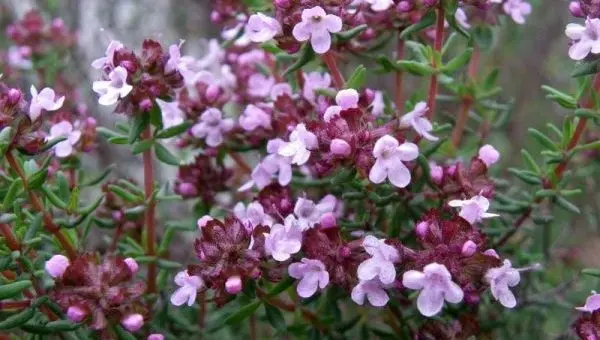
Cultivation is carried out in several ways: from seeds and, accordingly, from seedlings, cuttings and dividing the bush. Planting from seeds is the longest and most troublesome method, since the planting material does not have a high germination rate, and germinated sprouts develop very slowly. The best option in this case is sowing seeds for seedlings in a pot in early spring. In this case, in May, an already strong young plant can be planted in open ground.
Growing seedlings is carried out in any pot, plastic container, or other container. The earth needs to be loosened, well moistened, and then spread out on the surface of the seeds. Next, the planting material is covered with a 1 cm layer of earth, watered again, covered with glass, and sprouts are waiting for the appearance, which, under the right conditions, appear about 20 days after sowing. As soon as the sprouts began to appear, the glass is removed. Now all seedling care consists only in timely watering.

To sow seeds directly into the ground, you need to wait until the ground warms up. To get a thyme harvest on time, you should choose varieties with high germination and an early ripening period. Planting material is sown in shallow rows or holes to a depth of 0,5-1 cm at a distance of 3-5 cm. Next, the bed needs to be leveled and the soil well watered. With this method, seedlings usually appear by the end of the month, but it all depends on the weather conditions.
Care
Further care for thyme is as follows:
- about 2 weeks after germination, the seedlings need to be thinned out, leaving the strongest sprouts at a distance of 15 cm – the extra ones can be planted elsewhere;
- systematically, at least 1 time / 2 weeks, the beds need weeding and loosening;
- watering is carried out as needed, but regularly – it is important to ensure that the soil does not dry out, as this affects young plants very badly;
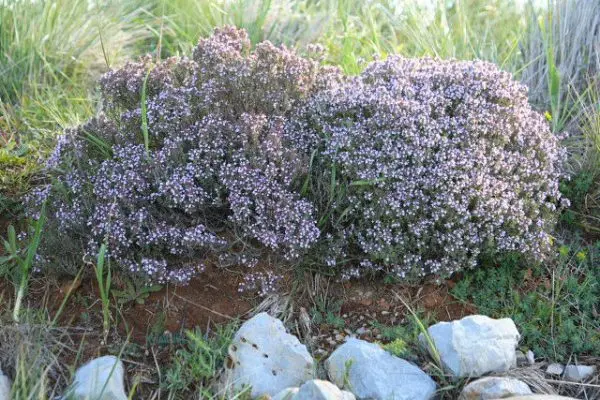
- fertilizers are applied several times per season: mineral mixtures (superphosphate, potassium salt, saltpeter) are applied during planting and before harvesting – this does not take into account the autumn fertilizing of the soil with organic matter;
- for the entire growing season, thyme needs a lot of heat and light – otherwise it will grow very slowly, and the content of esters in the ground part will be low;
- pests rarely appear on thyme bushes, but if this happens, the ground part of the bush must be treated with insecticides.
Propagation of the culture by dividing the root is permissible no earlier than the second year of the life of the bush, when the root system is fully expanded. Harvesting is carried out during the flowering period (June-August). The most suitable for harvesting thyme is July – during this period it blooms especially luxuriantly, and the maximum amount of active substances is concentrated in the shoots.
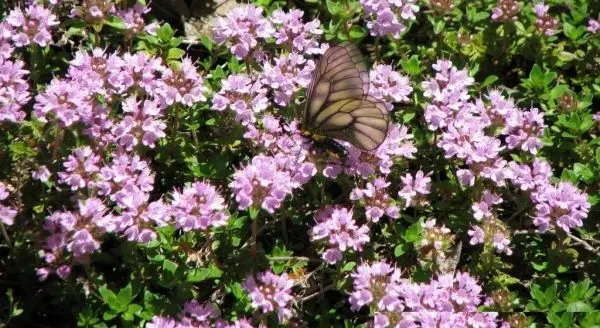
A flowering bush is cut with a sharp knife at a level of 5-7 cm above the ground – it is impossible to pluck or twist the plant with your hands, as the roots can be easily damaged. For the winter, the bushes need to be covered. Although thyme is a cold-hardy crop, it is still necessary to cover the roots with a layer of dry foliage to avoid freezing.
Video “All about landing”
An informative video where you can hear everything about planting thyme.









